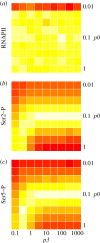A rule-based kinetic model of RNA polymerase II C-terminal domain phosphorylation
- PMID: 23804443
- PMCID: PMC3730697
- DOI: 10.1098/rsif.2013.0438
A rule-based kinetic model of RNA polymerase II C-terminal domain phosphorylation
Abstract
The complexity of many RNA processing pathways is such that a conventional systems modelling approach is inadequate to represent all the molecular species involved. We demonstrate that rule-based modelling permits a detailed model of a complex RNA signalling pathway to be defined. Phosphorylation of the RNA polymerase II (RNAPII) C-terminal domain (CTD; a flexible tail-like extension of the largest subunit) couples pre-messenger RNA capping, splicing and 3' end maturation to transcriptional elongation and termination, and plays a central role in integrating these processes. The phosphorylation states of the serine residues of many heptapeptide repeats of the CTD alter along the coding region of genes as a function of distance from the promoter. From a mechanistic perspective, both the changes in phosphorylation and the location at which they take place on the genes are a function of the time spent by RNAPII in elongation as this interval provides the opportunity for the kinases and phosphatases to interact with the CTD. On this basis, we synthesize the available data to create a kinetic model of the action of the known kinases and phosphatases to resolve the phosphorylation pathways and their kinetics.
Keywords: Kappa; rule-based modelling; transcription.
Figures




Similar articles
-
CDKF;1 and CDKD protein kinases regulate phosphorylation of serine residues in the C-terminal domain of Arabidopsis RNA polymerase II.Plant Cell. 2012 Apr;24(4):1626-42. doi: 10.1105/tpc.112.096834. Epub 2012 Apr 30. Plant Cell. 2012. PMID: 22547781 Free PMC article.
-
Dynamic phosphorylation patterns of RNA polymerase II CTD during transcription.Biochim Biophys Acta. 2013 Jan;1829(1):55-62. doi: 10.1016/j.bbagrm.2012.08.013. Epub 2012 Sep 7. Biochim Biophys Acta. 2013. PMID: 22982363 Review.
-
Phase-separation mechanism for C-terminal hyperphosphorylation of RNA polymerase II.Nature. 2018 Jun;558(7709):318-323. doi: 10.1038/s41586-018-0174-3. Epub 2018 May 30. Nature. 2018. PMID: 29849146 Free PMC article.
-
HIV-1 Tat interaction with RNA polymerase II C-terminal domain (CTD) and a dynamic association with CDK2 induce CTD phosphorylation and transcription from HIV-1 promoter.J Biol Chem. 2002 Sep 13;277(37):33922-9. doi: 10.1074/jbc.M111349200. Epub 2002 Jul 11. J Biol Chem. 2002. PMID: 12114499
-
Phosphorylation of the C-terminal domain of RNA polymerase II plays central roles in the integrated events of eucaryotic gene expression.J Biochem. 2007 May;141(5):601-8. doi: 10.1093/jb/mvm090. Epub 2007 Apr 3. J Biochem. 2007. PMID: 17405796 Review.
Cited by
-
Multi-state modeling of biomolecules.PLoS Comput Biol. 2014 Sep 25;10(9):e1003844. doi: 10.1371/journal.pcbi.1003844. eCollection 2014 Sep. PLoS Comput Biol. 2014. PMID: 25254957 Free PMC article.
-
Ribonucleoprotein particles of bacterial small non-coding RNA IsrA (IS61 or McaS) and its interaction with RNA polymerase core may link transcription to mRNA fate.Nucleic Acids Res. 2016 Apr 7;44(6):2577-92. doi: 10.1093/nar/gkv1302. Epub 2015 Nov 24. Nucleic Acids Res. 2016. PMID: 26609136 Free PMC article.
-
Generalizing Gillespie's Direct Method to Enable Network-Free Simulations.Bull Math Biol. 2019 Aug;81(8):2822-2848. doi: 10.1007/s11538-018-0418-2. Epub 2018 Mar 28. Bull Math Biol. 2019. PMID: 29594824 Free PMC article.
-
Keep calm and reboot - how cells restart transcription after DNA damage and DNA repair.FEBS Lett. 2025 Jan;599(2):275-294. doi: 10.1002/1873-3468.14964. Epub 2024 Jul 11. FEBS Lett. 2025. PMID: 38991979 Free PMC article. Review.
References
-
- Ollivier JF, Shahrezaei V, Swain PS. 2010. Scalable rule-based modelling of allosteric proteins and biochemical networks. PLoS Comput. Biol. 6, e1000975.10.1371/journal.pcbi.1000975 (doi:10.1371/journal.pcbi.1000975) - DOI - DOI - PMC - PubMed
-
- Bachman JA, Sorger P. 2011. New approaches to modeling complex biochemistry. Nat. Methods 8, 130–13110.1038/nmeth0211-130 (doi:10.1038/nmeth0211-130) - DOI - DOI - PMC - PubMed
-
- Danos V, Feret J, Fontana W, Harmer R, Krivine J. 2007. Rule-based modelling of cellular signalling. In CONCUR 2007: concurrency theory (eds Caires L, Vasconcelos V.). Lecture Notes in Computer Science, vol. 4703, pp. 17–41 Berlin, Germany: Springer
-
- Elliot D, Ladomery M. 2011. Molecular biology of RNA. Oxford, UK: Oxford University Press
-
- Palancade B, Marshall NF, Tremeau-Bravard A, Bensaude O, Dahmus ME, Dubois M-F. 2004. Dephosphorylation of RNA polymerase II by CTD-phosphatase FCP1 is inhibited by phospho-CTD associating proteins. J. Mol. Biol. 335, 415–42410.1016/j.jmb.2003.10.036 (doi:10.1016/j.jmb.2003.10.036) - DOI - DOI - PubMed
Publication types
MeSH terms
Substances
Grants and funding
LinkOut - more resources
Full Text Sources
Other Literature Sources

